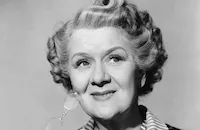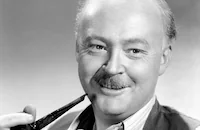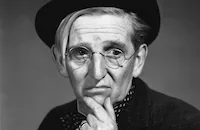The Amazing Mr. Williams

Brief Synopsis
Cast & Crew
Alexander Hall
Melvyn Douglas
Joan Blondell
Clarence Kolb
Ruth Donnelly
Edward S. Brophy
Film Details
Technical Specs

Synopsis
Kenny Williams, a homicide detective, realizes that his job is interfering with his love life as everytime he makes a date with his sweetheart Maxine Carroll, the mayor's secretary, he has to cancel it because of an important case. Tired of being neglected, Maxine tries to convince Kenny to switch jobs. She resorts to desperate means when she reports Kenny to his superior, Captain McGovern, after he shows up for a date handcuffed to a prisoner he was supposed to have escorted to jail. When Kenny learns that Maxine influenced McGovern's decision to threaten him with suspension for refusing to accept an assignment requiring him to impersonate a woman in order to trap a lady killer, Kenny takes the job just to spite her. One night, Maxine goes out to look for Kenny and is attacked by the killer just as Kenny is ready to pounce on him. After the attack, Maxine finally succeeds in convincing Kenny to quit the police force, but on the day of their wedding, Kenny finds himself back in the fray when a bank is held up and a night watchman is killed. A coloring book found at the scene of the crime leads to the arrest of a man named Stanley, and although Stanley protests that he was forced to open the bank vault while another man shot the night watchman, he is found guilty. Kenny believes Stanley to be innocent and while delivering Stanley to prison, he notices a powder burn on the back of his coat, evidence that could substantiate his innocence. Pulling Stanley from the train, Kenny races to Maxine's apartment and persuades her to steal from the mayor's office the bottle that had served as evidence during the trial. The bottle leads Kenny to Reagan, the real criminal, whom he captures at the racetrack. After Stanley is exonerated, Maxine is awarded with the title of special deputy for her help in capturing Reagan, and she and Kenny are married. On their honeymoon night, Maxine insures their privacy by cutting the telephone wires, but when an officer arrives at their home summoning all special deputies to the station, Maxine makes a cheerful and hasty exit.

Director

Alexander Hall
Cast

Melvyn Douglas

Joan Blondell

Clarence Kolb

Ruth Donnelly

Edward S. Brophy

Donald Macbride

Don Beddoe

Jonathan Hale

John Wray
Robert Middlemass

Barbara Pepper
Luis Alberni

Peggy Shannon

Richard Lane

Maude Eburne
Ralph Peters

Walter Miller
William Hall
William Forrest
John Locke
Dick Curtis
Lorna Gray
Eddie Laughton
William Newell
Herbert Clifton
Jack Chefe
Bill Lally
Stanley Brown

Robert Sterling
Eleanor Wood
Eva Mckenzie
Josef Forte
Jan Hopper
Cynthia Crane
William Tracy

James Conlin
Anthony Warde
Virginia Sale
Sally Payne
Ada Mae Moore
Harrison Greene
Eddie Fetherston
Dave Willock
Milt Kibbee

Walter Sande
Charles Mcavoy
Fred Warren
James Crane
Casey Johnson
Maurice Cass
Blanche Payson
Sidney D'albrook
Hans Schumm
Tommy Mullins
Grace Goodall
Wyndham Standing
Sarah Edwards
Lela Bliss
Frank Jaquet
Robert Dudley
Jane Barnes
Jennifer Gray
Rita Owin
Richard Scott
Crew
Lionel Banks
Sy Bartlett
Sy Bartlett
Thomas Flood
Frank Goodwin
Kalloch
Viola Lawrence
Richard Maibaum
Everett Riskin
M. W. Stoloff
Dwight Taylor
Arthur Todd

Film Details
Technical Specs

Articles
The Amazing Mr. Williams - The Amazing Mr. Williams
The idea of mixing mystery and comedy was nothing new by 1939. Like most Hollywood studios, Columbia was trying to copy MGM's successful Thin Man films, which had raised eyebrows in 1934 with their sophisticated take on murder and modern marriage. Columbia had even tried to team Douglas and Blondell in a similar story as husband-and-wife private detectives in There's Always a Woman (1938). That franchise had failed to take off, however, so they were back in 1939 with different characters drawn from a play by co-writer Sy Bartlett. Finding humor in what were then termed "stranger killers" was a little outré and it wouldn't be until the '70s that the term serial killer was commonly used. Nonetheless, Douglas got into drag, without shaving the moustache that was his trademark at the time, to prevent the lady killer from claiming another victim.
The Amazing Mr. Williams had a fascinating group of writers working on it. Sy Bartlett would achieve his greatest fame after World War II when he drew on his Air Force experience (he was the first man to drop bombs on Berlin during the war) to co-write the novel Twelve O'Clock High. That would lead to a long association with the film's star, Gregory Peck, for whom he produced the classic, and the much more serious thriller Cape Fear (1962). Bartlett's co-writer on The Amazing Mr. Williams was also destined for greater things. After years of lesser assignments in Hollywood, Richard Maibaum would relocate to England and forge a partnership with producer Albert "Cubby" Broccoli, for whom he would write 13 James Bond films, from Dr. No (1962) to Licence to Kill (1989).
As outrageous as it was, The Amazing Mr. Williams was naturally destined for problems with the Production Code. Among things objected to by the Hayes Office were references to drag and a "sex maniac." The censors also insisted that the female impersonation have "absolutely no suggestion of a 'pansy' flavor or 'pansy' gags of any kind" and that Douglas' trip to buy women's clothes for his disguise not include a visit to the underwear department. The PCA also insisted that the script omit references to crooks covering the license plates on their getaway cars and wearing gloves to conceal fingerprints. Such omissions were standard for the era and part of the belief that putting such information in films would teach people how to become more efficient criminals.
The film set of The Amazing Mr. Williams was something like a family reunion. Douglas and Blondell had worked together not just on There's Always a Woman but also on Good Girls Go to Paris (1939), both of which had been directed by Alexander Hall, a comedy specialist at Columbia also assigned to The Amazing Mr. Williams. When Blondell turned 33 during filming, shooting stopped for the presentation of a large cake and visits from stars like Lucille Ball, who were working nearby.
The Amazing Mr. Williams also featured a sterling compliment of character players. Blondell's boss, the town's mayor, was played by one of the screen's most famous bosses, Jonathan Hale, who played Dagwood's boss, Mr. Dithers, in most of Columbia's Blondie films. Blondell's wise-cracking roommate was Ruth Donnelly, a comedienne who had just played Guy Kibbee's wife in Mr. Smith Goes to Washington (1939). Another of the screen's most famous bosses, Clarence Kolb, played Douglas' police captain. He would be best remembered as Charles Farrell's boss on the early television hit My Little Margie. Smaller roles went to dialect comic Luis Alberni, grizzled Maude Eburne, Preston Sturges regular Jimmy Conlin and Barbara Pepper, the one time gold digger type who achieved her greatest fame as the adoptive (but don't tell her) mother of Arnold the Pig on Green Acres. On the road to greater success were Julie Bishop -- who appears as a murder victim photo in the newspaper, just before a move to Warner Bros., where she would become a reliable leading lady opposite stars like Errol Flynn and Humphrey Bogart -- and Robert Sterling, who appears unbilled as an "Elevator Boy." Although he had been in the running for the lead in Golden Boy (1939) (which went to William Holden), it would take a move to MGM in 1941 to bring him better screen roles and a television stint as the ectoplasmic George Kirby in Topper, opposite wife Anne Jeffreys, to make him a star.
Producer: Everett Riskin
Director: Alexander Hall
Screenplay: Sy Bartlett, Richard Maibaum, Dwight Taylor
Based on the play by Bartlett
Cinematography: Arthur L. Todd
Art Direction: Lionel Banks
Music: Felix Mills
Principal Cast: Melvyn Douglas (Lieutenant Kenny Williams), Joan Blondell (Maxine Carroll), Clarence Kolb (Captain McGovern), Ruth Donnelly (Effie), Edward Brophy (Buck Moseby), Donald MacBride (Lieutenant Bixler), Don Beddoe (Deever), Jonathan Hale (Mayor), Luis Alberni (Rinaldo), Julie Bishop (Face of 7th Victim in Newspaper Photo), Jimmy Conlin (Master of Ceremonies), Maude Eburne (Landlady), Barbara Pepper (Muriel), Robert Sterling (Elevator Boy).
BW-80m.
by Frank Miller

The Amazing Mr. Williams - The Amazing Mr. Williams
Quotes
Trivia
Notes
A working title for this film was The Incredible Mr. Williams. The file for the film in the MPAA/PCA Collection at the AMPAS Library indicates that the PCA, after reading the script, urged Columbia to remove the following from the picture: the dialogue, "I got a little apartment just around the corner," and "Me! In drag!"; the expression "sex maniac"; the goosing gag of "Kenny" striking a match on another actor's rear; details of the safe robbery, including the fake cardboard front of the safe, the covering up of license plates of the cars and references to the wearing of gloves to avoid leaving fingerprints. In addition, the PCA demanded the "careful handling" of the female impersonation scenes, and insisted that there be "absolutely no suggestion of a 'pansy' flavor or 'pansy' gags of any kind." The PCA also requested that a scene showing a male actor buying women's clothes be "handled in good taste, omitting the display of the more intimate feminine garments."














